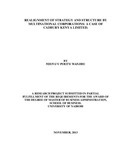| dc.description.abstract | It is observed that in many organizations, annual strategic plans do not include organizational structure elements that play an integral role in achieving corporate goals and objectives. This is because the link between strategy and structure is still in its infancy stage. Various conflicting theories on this relationship exist, some stating that structure follows strategy, others claiming that it is strategy that follows structure while others claim that their relationship is interchangeable. The study recognized that there was a link between strategies and structure and sought to establish how Cadbury Kenya Limited realigned its structure to fit its new strategies and why it was important for it to realign its new strategies and structure. It adopted a qualitative research design in the form of a case study since the unit of analysis was one organization. Primary data was collected using an interview guide which contained both open and closed-ended questions. Content analysis was then used to present the data. The information was presented in a continuous prose. The study found that several factors had been considered during the realignment including: business processes and value chain, corporate culture, new technologies, empowerment of human resources, cost reduction and competition. The study also found the most significant importance of the realignment to be: cost reduction, increased competitive advantage, improved business processes and work flow as well as structural flexibility. The study recommended that other studies be conducted with regard to the challenges faced in realignment, control systems put in place to monitor the success of realignment. It also recommended that multinational corporations consider technology as a significant facilitator of the realignment process | en |

